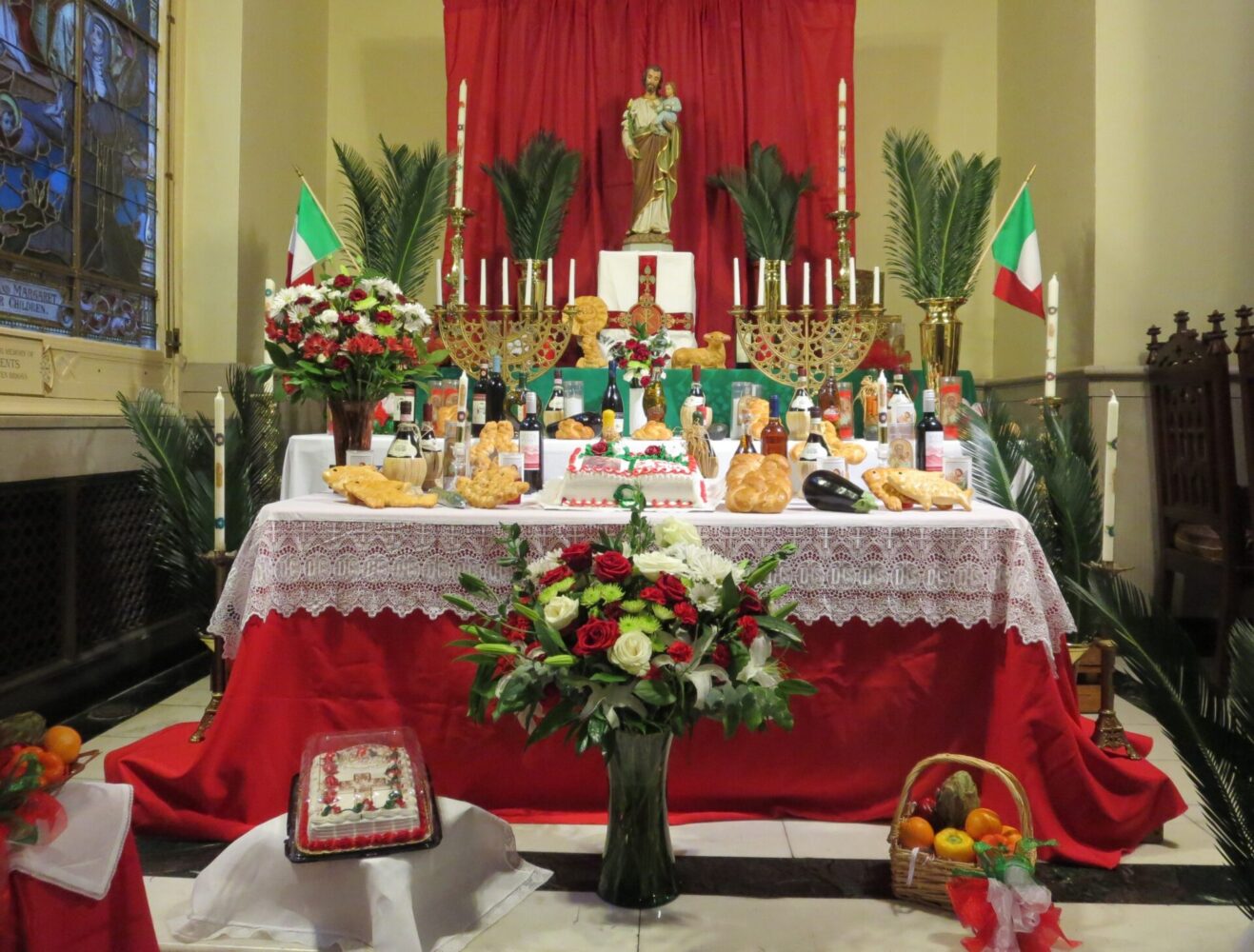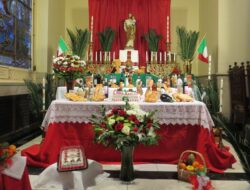St. Joseph Altars
Catholic Louisianans of Sicilian descent erect altars laden with fresh produce, baked goods, and other foods to honor Saint Joseph.

Louisiana Endowment for the Humanities
St. Joseph's Day Altar at Immaculate Conception Jesuit Church in New Orleans, March 19, 2024. Photo by Erin Greenwad.
In the days leading up to Saint Joseph’s Day, March 19, in southeast Louisiana, Catholics of Sicilian descent build elaborate altars laden with feasts honoring the saint for saving their ancestors from starvation. According to lore, during the Middle Ages drought led to a famine in Sicily, so the people prayed to their patron saint, Saint Joseph, for aid. The starving Sicilians soon found nourishment in a bounty of fava beans (previously used as animal fodder) and attributed their survival to Saint Joseph. In gratitude, disciples erected altars to honor their saint. Today Saint Joseph altars are usually built for one of three reasons: to ask Saint Joseph for a wish, to thank him for answering a prayer, or to honor the recently departed. Altars are seen as a conduit to the saint himself, as sacred contracts often passed down through generations.
St. Joseph Altars Arrive in New Orleans
Following the Civil War and the abolishment of the slavery, Sicilian farm workers, mostly male, migrated to New Orleans to work the plantations. As their numbers grew, many men stayed and sent for their wives and children. The growing Sicilian population added the altars to the already vibrant Catholic Creole traditions. Originally, these private installations were open to friends and family and those who knew the sign for entrance, a palm frond over the door. As this tradition became established in New Orleans and the surrounding area, it emerged as a public expression of Sicilian culture often advertised in the personal and classified sections of the local newspapers. Tucked in between advertisements for palm readers and lost pets, the addresses of St. Joseph’s Day altars are found to this day.
Altar Composition and Symbolism
According to historian Ethelyn Orso, there are three types of altars: those that are built in a private home; those in commercial spaces, usually a sweet shop or restaurant; and large altars funded and run by churches, institutions, or organizations. The altars vary physically but are usually built in three tiers representing the Holy Family, with a statue of Saint Joseph perched on top and surrounded by blessed palm leaves, flowers, or greenery. Many embrace the palette of the Italian flag—green, white, and red—whereas others use the primary colors of the Sicilian flag, red and yellow. Often a labor of love, these altars feature bright textiles and artistically arranged displays of food, much of which is served to visitors as nourishment for the body and symbols to feed the soul.
Because Saint Joseph’s Day falls during Lent, no meat is served or displayed on the altar, but vegetables, seafood, breads, and sweets are offered. Bright raw peppers, lemons, oranges, grapes, artichokes, fennel, onions, garlic, apples, and pears add color to the already lively presentation. Cooked dishes like stuffed artichokes, omelets called froscia, cardoons, fried fish, and other seafood specialties of Sicily abound. These include Saint Joseph’s pasta, or pasta Milanese, which uses a meatless tomato sauce with anchovies, raisins, and fennel that is finished with a sprinkling of mudica, seasoned and sweetened breadcrumbs that are toasted brown to imitate the sawdust from Joseph’s workbench.
Altars also feature shaped breads representing crosses, hearts, wreaths, hammers, and nails (symbolizing Joseph’s work as a carpenter), sandals, and fish. Fanciful cakes shaped as lambs, hearts, and open Bibles grace the altars alongside cookies, including pignolati, balls of fried dough that have been rolled in sugar syrup and formed into a shape that, according to lore, represents the pinecones Jesus used to play with. Arguably the most popular cookies on a New Orleans altar are cuccidati, which are filled with sweetened fig, citrus paste, and spices, dipped in white or colorful icing, and sprinkled with nonpareils.
Cuccidati are also formed into large, artistically crafted centerpieces of many altars. This artform is disappearing, and today such centerpieces are often made of non-edible dough so they can be used year after year.
Upon exiting altars, guests often receive a goody bag containing a fava bean, a couple of cookies, a Saint Joseph prayer card, and a small piece of Saint Joseph’s bread, chewy on the inside and crusty on the outside and sprinkled with sesame seeds. Believers keep the fava bean in their wallets or purse because, allegedly, those who do will never be without money. They also keep the piece of bread to throw into a storm, believing that Saint Joseph will quell it.
Altars have become a vehicle of Sicilian culture, bringing together neighbors to celebrate life’s great pleasures of eating and sharing food communally. Food symbolizes not only the earthly bounty, called abbondanza (abundance) in Italian, but also the feast that awaits Catholics in the afterlife.
